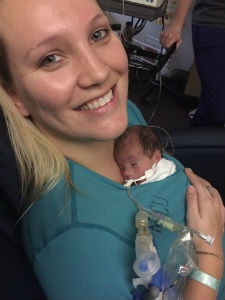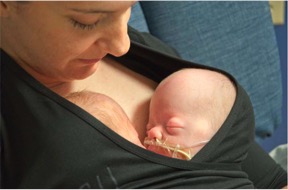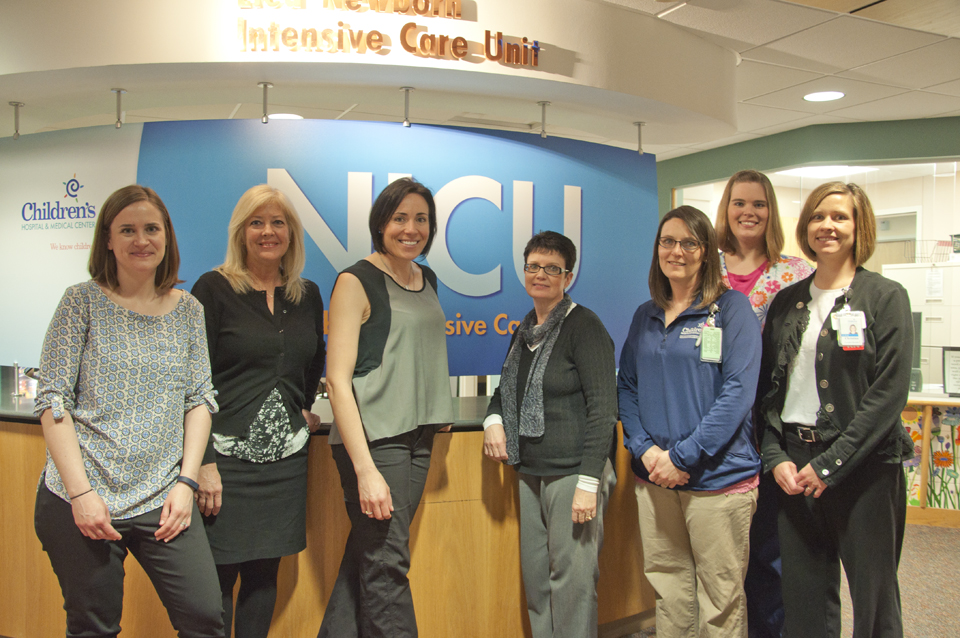Over the past few months, our team has had the honor of traveling to and meeting with several NICU teams around the country. Today, we wanted to highlight a NICU that is going above and beyond in their developmental care and family-centered care practices.
We had the pleasure of meeting with members of the Omaha Children’s NICU team to talk about Kangaroo Care (KC), also called skin-to-skin, and implementing the NüRoo Pocket as a tool for safely increasing KC time for mom + baby. What follows are some snippets from our conversation with their phenomenal nurses, lactation consultants and developmental care staff. Omaha Children’s Neonatal Intensive Care Unit, thank you for everything you do!
NüRoo: Tell us about how skin-to-skin became a priority in your unit.
Omaha Children’s: We’ve always encouraged skin-to-skin, and we just keep getting better and better at it! Our director is a firm believer in developmental care for sick, preterm babies, and skin-to-skin is a core practice in line with developmental care. One of the driving forces for us was that one of our RN’s was required to do an evidence-based project during residency, and she decided to investigate Kangaroo Care and its benefits. She joined our Developmental care team, and we supported sending some of our nurses to conferences, including NANN and the United States Institute for Kangaroo Care. It took multiple champions, but together as a team, our skin-to-skin initiative took shape!
NüRoo: What have you observed in babies that spend more time skin-to-skin?
Omaha Children’s: Better weight gain overall, and babies that are more rested and calm after a skin-to-skin session. When they rest better, they burn fewer calories and gain more weight. That’s what we strive for – comfortable babies. We also see their oxygen needs go down when they’re doing skin-to-skin.
NüRoo: How do you use skin-to-skin for pain relief?
Omaha Children’s: The babies in our unit that spend time in Kangaroo Care need less pain meds. We also allow babies to be skin-to-skin during minor procedures like heel sticks, which decreases baby’s pain and gives mom and dad something only THEY can do for their baby.
NüRoo: How do you educate families about skin-to-skin?
Omaha Children’s: We have families watch an instructional video showing transfers before they hold their baby skin-to-skin the first time. We find this really helps parents be more confident and less anxious. We try to normalize the experience as much as possible. We also explain all the physiological benefits of the practice to families so they know how important it is for them to provide this care for their baby.
NüRoo: How do you document time spent skin-to-skin?
Omaha Children’s: When we began our KC initiative, we started noting in Epic when a session started and ended. It also pulls in the stats, heart rate, BP. Nurses note if baby tolerated or did not tolerate. Every month, we review the data to make sure that no lines are lost, there are no extubations, babies are tolerating well, etc.
NüRoo: What made you go out and look for a product to support skin-to-skin?
Omaha Children’s: As we developed our Kangaroo Care guidelines, we realized we needed something to help ensure babies would be safe during KC. Prior to using the NüRoo Pocket, we were using a blanket on top of baby and felt it was just not secure enough for proper positioning. Mom was in charge of all the tubes and baby was sliding down. We don’t have an open bay unit, so making sure baby maintains position is critical in our single patient rooms. We did try different slings and wraps, and the Pocket was the easiest, by far, to use. You don’t have to tie it, it’s just Velcro and it’s very nice. Babies are snug and secure. Moms feel more secure because they know baby is safe.
From a nursing perspective, tubes and lines are contained and more secure when using the Pocket. With just a blanket, movement can cause those lines and leads to be disrupted. We also love that we can have immediate access to baby due to the Pocket’s design. Since our preterm infants aren’t placed in the inside Pocket, all we have to do is lift or open the shirt and we have complete access to baby in a second.
NüRoo: How did you implement Kangaroo Care with the NüRoo Pocket?
Omaha Children’s: After we selected the Pocket as the device we would use, we trained the nurses. We first demonstrated the NüRoo Pocket at a staff meeting and the nurses put them on and we also used mannequins to display how they could use them. They walked around in the unit with the shirts on with a doll. It showed nurses how secure the babies were and how easy the access was for procedures and assessments. We have also worked on making it a unified process with Respiratory Therapists who are always involved for transferring a baby that is intubated. We also set up mock rooms on all of the floors to come in and practice, too. We figured out how we were going to wash them and where we would store them.As a 40-bed unit with an average daily census of 30 patients, we started with 12 Pockets on each floor. We leave them in the room for the families and then we go through the unit, collect them, and wash them after 3-4 days.
NüRoo: Did you take the TJC Infant Falls/Drops Quality Measure into account when you were looking for a KC device?
Omaha Children’s: When you’re doing any kind of transferring or holding, and when you think of postpartum moms being so tired…. The shirt, because it is so secure, if they drift off (which we don’t encourage), we know that baby will be safe from being dropped when they have the Pocket on, even if we’re not in the room with them.
NüRoo: What do nurses think of the Pocket?
Omaha Children’s: We have seen an increase in nursing satisfaction for those that have really used it. They really like it! There are always a few that like to stick to the way they’ve always done it, but once they try the Pocket, they keep using it. The best benefit of the Pocket for nursing staff is that it keeps the tubes and lines so stable. We feel so secure that everything is kept in place and baby is very easy to access if we need to with the Pocket.
NüRoo: What about parents? What do they think?
Omaha Children’s: We had a mom that did KC for the first time with her baby without the Pocket and it did not go well. When Mom was ready to do KC the second time, we had her use the Pocket. The Mom raved about the shirt and never did KC without it again! Once we introduced the Pocket, the families just loved them. Now our biggest concern is trying to keep them from walking away. So, we’re now bringing them into the unit as a chargeable item for when a family wants to purchase them and we also have them in our gift shop. If a family can’t afford one, we do have a way to give them one as a charitable donation.
 NICU Mom with her one-month old baby in the Pocket
NICU Mom with her one-month old baby in the Pocket
NüRoo: Some hospitals need help determining how to fund an investment in the NüRoo Pocket. Can you tell us what the process was like for you?
Omaha Children’s: We are blessed to have a very generous Foundation. We had a lot of money dedicated to supporting families and developmental care. So, we used some of that to purchase the Pockets to trial. We were especially looking for a way to promote KC with our Level IV and very low birth weight babies, without doing any harm.
NüRoo: Were there any obstacles along the way?
Omaha Children’s: It can be difficult because Neonatologists and a lot of NICU staff are rightly conservative and initially skeptical, and worry that the Level IV babies will have bradycardia or desat. We worked on a guideline for when babies could safely come out to do skin-to-skin as a team. Babies that are intubated and have PICC lines can safely come out. When you see all of the benefits that the babies get with skin-to-skin, you just can’t help but know that it’s the best thing for them! Neuro-development of baby is so important and we know we promote neuro-development with each skin-to-skin session. That bonding is so important because parents have such a lack of control in the NICU and with Kangaroo Care, parents know they’re making a difference.
NüRoo: Have you done any special programs with patients to promote skin-to-skin?
Omaha Children’s: We had a contest for our parents to encourage them to Kangaroo Care that was really cool. We had a box at the nursing station and every time a parent practiced skin-to-skin, we put a strip in the box. Parents with the most strips would get a shirt or a blanket. Parents loved it! It also helped the nurses get in tune that we need to do it every day.
NüRoo: What should families know about practicing skin-to-skin after they go home?
Omaha Children’s: It should continue throughout the postpartum period! The more the better. The benefits continue long after discharge.
 NICU Mom with her twin babies in the Pocket
NICU Mom with her twin babies in the Pocket
NüRoo: Is there anything you would say to a NICU nurse or parent that is uncertain about skin-to-skin?
Omaha Children’s: Encourage, encourage, encourage. It’s very satisfying to put a baby on a mom’s chest, a scared mom even, to help her get through that as well, and get over her fears and enjoy that baby, and fall in love with that baby on her chest.
*Featured in team photo above, left to right:
Brownmed/NüRoo Team: Kylia Garver, MPH, VP of Clinical Innovation; Sharon Wood, RN, BA, BSN, Medical Liason; Hope Parish, PA-C, Director of Hospital Strategy
Omaha Children’s NICU Team: Donnetta Perkins, RN, BSN, PMP, CNML, Director NICU/Fetal Care Center; Nicole Nazaruk, BSN, RN, RNC-NIC Clinical Education Resource Nurse NICU; Chelli Westengaard, OTR/L, Developmental Care Specialist; and Christi Schill, RN, BSN, IBCLC, Lactation Specialist
Although not in the photo, we also loved meeting with the following equally amazing people at Omaha’s Children’s NICU: Zahi Zeidan, MD Neonatologist; Nicole Birge, MD Neonatologist; Heather Kneifl, BSN; Sandy Gebers, BSN; and Tammi Martin, RN, BSN, IBCLC, Lactation Specialist.

